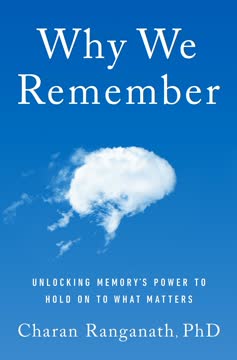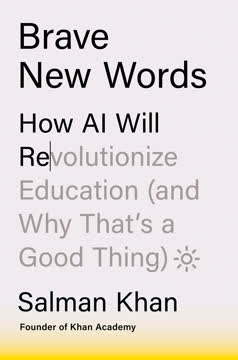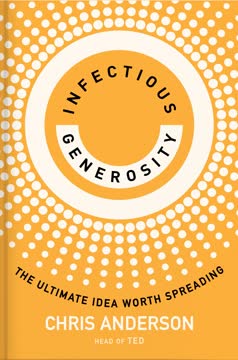Key Takeaways
1. Generosity is a powerful force that can spread infectiously through society
Any generous act can have extraordinary impact if it can make the leap from isolated to infectious.
Ripple effects. Acts of generosity, no matter how small, have the potential to create chain reactions that spread far beyond the initial giver and recipient. When people witness or experience kindness, they are often inspired to "pay it forward" and be generous themselves. This creates a positive feedback loop that can amplify the impact of a single generous act many times over.
Visibility matters. For generosity to become truly infectious, it needs to be noticed and shared. Social media and online platforms have created unprecedented opportunities for stories of kindness to reach global audiences. Videos of strangers helping each other or heartwarming acts of charity can quickly go viral, touching millions of lives. By actively seeking out and sharing stories of generosity, we can help shift cultural norms and inspire more people to give.
Cultural transformation. As generosity spreads, it has the power to counteract cynicism and division in society. It reminds us of our shared humanity and capacity for kindness. Over time, a culture of generosity can emerge, where giving becomes the expected norm rather than the exception. This can lead to stronger communities, increased social trust, and a more compassionate world.
2. The Internet has transformed the potential for generosity to have global impact
Everything's untouched / But forever changed… / Everywhere on earth / Every single soul / Everyone there is / All together now
Unprecedented connectivity. The Internet has fundamentally changed how we can express generosity. It allows us to:
- Share knowledge and resources with people anywhere in the world
- Collaborate on global initiatives and movements
- Crowdfund projects and causes
- Amplify stories of kindness to massive audiences
New forms of giving. Digital platforms have enabled innovative ways to be generous:
- Open-source software and content creation
- Online mentoring and skill-sharing
- Virtual volunteering opportunities
- Micro-lending and direct cash transfers to those in need
Challenges and opportunities. While the Internet has also amplified negativity and division, it holds immense potential as a force for good. By consciously choosing to use online spaces for generosity and connection, we can help shift the digital landscape. This requires both individual actions and collective efforts to create healthier online communities and platforms that encourage prosocial behavior.
3. Humans are biologically wired for generosity, which brings happiness and fulfillment
If you want happiness for an hour, take a nap. For a day, go fishing. For a month, get married. For a year, inherit a fortune. For a lifetime, help somebody else.
Evolutionary advantage. Generosity is not just a cultural construct, but a deeply ingrained part of human nature. Our capacity for altruism and cooperation gave our ancestors a survival advantage, allowing groups to thrive. This has left us with strong instincts and emotional rewards for helping others.
The science of giving. Research consistently shows that generous acts boost happiness and well-being:
- Activates pleasure centers in the brain
- Reduces stress and improves physical health
- Increases sense of meaning and purpose
- Strengthens social connections
Overcoming barriers. While we have the capacity for generosity, we also have competing instincts for self-preservation and accumulation. Recognizing the long-term benefits of giving can help us overcome short-term reluctance. Cultivating gratitude and empathy can also make generosity feel more natural and rewarding.
4. There are many ways to give beyond money, including attention, knowledge, and creativity
Generosity wants to spread. Let's grant it its wish.
Diverse forms of giving. While financial donations are important, generosity encompasses a wide range of actions:
- Attention: Truly listening to others, offering emotional support
- Bridging: Reaching out to those with different views, building understanding
- Knowledge: Sharing skills, mentoring, creating educational content
- Connection: Introducing people, building networks
- Hospitality: Welcoming others, creating inclusive spaces
- Enchantment: Using art and creativity to inspire and uplift
Accessible to all. These non-monetary forms of generosity are available to everyone, regardless of financial means. They often require only time, effort, and a willingness to engage with others. By recognizing these diverse ways of giving, we can see opportunities for generosity in our daily lives.
Amplifying impact. In the digital age, acts of non-monetary generosity can have outsized effects. A single YouTube tutorial can educate millions. A thoughtful blog post can spark a movement. By combining creativity with technology, individuals can create ripple effects of positive change far beyond their immediate circle.
5. Companies and organizations can benefit greatly from embracing generosity
If you are right with your people, if you are right with your community, if you are right with your product, you will be more profitable, you will be more innovative, you will have more passionate people working for you and a community that supports you.
Shifting paradigms. The traditional view of business as purely profit-driven is evolving. Companies are recognizing that generosity and social responsibility can be powerful drivers of success. This includes:
- Treating employees well and investing in their growth
- Engaging in meaningful philanthropy and community involvement
- Prioritizing sustainability and ethical practices
- Sharing knowledge and resources openly
Tangible benefits. Embracing generosity can lead to:
- Improved brand reputation and customer loyalty
- Increased employee satisfaction and retention
- Innovation through collaboration and open-source approaches
- New market opportunities and partnerships
Leading by example. Companies like Patagonia, Chobani, and others have shown that generous business practices can be highly successful. As more organizations adopt this approach, it has the potential to reshape capitalism into a more sustainable and equitable system.
6. Strategic philanthropy can tackle major global challenges at scale
If we could give the world's changemakers a chance to dream much bigger?
Thinking big. Traditional philanthropy often focuses on small-scale, local interventions. However, there's enormous potential in directing resources towards ambitious, global-scale solutions. This requires:
- Identifying the most pressing and neglected problems
- Supporting innovative, high-leverage approaches
- Collaborating across sectors and borders
- Being willing to take calculated risks
The Audacious Project. Initiatives like The Audacious Project demonstrate the power of strategic philanthropy:
- Brings together visionary change-makers and major donors
- Funds bold ideas that could impact millions of lives
- Provides long-term support to scale solutions
- Creates a marketplace for transformative philanthropic investments
Catalyzing change. Strategic philanthropy can play a crucial role in addressing global challenges by:
- Funding early-stage research and innovation
- Demonstrating the viability of new approaches
- Leveraging additional resources from governments and businesses
- Building coalitions and movements for systemic change
7. A generosity pledge could revolutionize global giving and change the world
If good-thinking people could agree on a generosity pledge as a social norm, it would do four key things:
The pledge concept. Combining ancient traditions of tithing and zakat, a modern generosity pledge encourages people to give annually:
- The higher of 10% of income or 2.5% of net worth
- Customizable starting points for different circumstances
- Gradual increases over time as able
Potential impact. If widely adopted, this level of giving could raise trillions of dollars annually, enough to:
- End world hunger
- Provide universal education and healthcare
- Tackle climate change
- Fund breakthrough scientific research
- Address nearly every major global challenge
Cultural shift. Beyond the financial impact, a generosity pledge could:
- Create a shared societal commitment to giving
- Encourage more strategic and impactful philanthropy
- Inspire conversations about generosity and global responsibility
- Build a sense of global community and shared purpose
8. Reclaiming the Internet as a force for good is crucial for humanity's future
If we can find a way to nudge the Internet to a kinder, more generous, more positive place, it could have an incalculable impact on our future, both directly and by providing a healthier foundation for AI.
Current challenges. The Internet has become a breeding ground for division, misinformation, and negativity. This is driven by:
- Algorithms that prioritize engagement over quality
- Business models based on capturing attention at any cost
- The ease of anonymous attacks and trolling
- Echo chambers that reinforce existing beliefs
Pathways to improvement. Reclaiming the Internet requires action on multiple fronts:
- Individual choices to spread positivity and bridge divides
- Platform design that encourages thoughtful interaction
- New business models that don't rely on exploiting human psychology
- Collective efforts to create healthier online norms and spaces
Stakes are high. The Internet shapes how we perceive the world and interact with each other. As AI becomes more powerful, it will be trained on our online behavior. Creating a more generous and constructive Internet is crucial for:
- Preserving social cohesion and democracy
- Fostering global cooperation on shared challenges
- Ensuring that AI development is guided by our best qualities, not our worst
Last updated:
FAQ
What's "Infectious Generosity: The Ultimate Idea Worth Spreading" about?
- Core Theme: The book explores the transformative power of generosity, arguing that acts of kindness can have exponential impacts and are as contagious as any virus.
- Structure: It is divided into three parts: "Why," "How," and "What If?" Each section delves into different aspects of making generosity infectious.
- Evidence and Stories: Chris J. Anderson combines data with moving stories to illustrate how small acts of kindness can lead to significant positive changes.
- Generosity as a Contagion: The book suggests that generosity can counteract divisiveness and bring about a new era of hope.
Why should I read "Infectious Generosity: The Ultimate Idea Worth Spreading"?
- Inspiration: The book offers a hopeful perspective in a time often characterized by division and negativity.
- Practical Advice: It provides actionable steps on how to make generosity a part of daily life and how to amplify its effects.
- Unique Perspective: Anderson presents generosity as a powerful force that can be harnessed to improve both personal happiness and societal well-being.
- Engaging Stories: The book is filled with real-life examples that demonstrate the impact of generosity, making it both informative and emotionally engaging.
What are the key takeaways of "Infectious Generosity: The Ultimate Idea Worth Spreading"?
- Generosity is Contagious: Acts of kindness can spread rapidly, influencing others to act similarly.
- Impact of Small Acts: Even small, seemingly insignificant acts of generosity can lead to large-scale positive changes.
- Role of the Internet: The book highlights how the Internet can be a tool for spreading generosity, despite its current role in fostering division.
- Personal and Societal Benefits: Generosity not only benefits recipients but also enhances the giver's happiness and sense of purpose.
How does Chris J. Anderson suggest we make generosity infectious?
- Shift Attention: Focus on others' needs and stories to initiate acts of kindness.
- Build Bridges: Engage with those you disagree with to foster understanding and reduce division.
- Share Knowledge: Use your skills and knowledge to help others, creating a ripple effect of generosity.
- Leverage the Internet: Utilize online platforms to amplify acts of kindness and spread positive stories.
What are the best quotes from "Infectious Generosity: The Ultimate Idea Worth Spreading" and what do they mean?
- "You don’t need to be big to be powerful. You just need to be infectious." This quote emphasizes that small acts can have a large impact if they spread widely.
- "Generosity is the ultimate idea worth spreading." Anderson argues that generosity is a foundational concept that can lead to widespread positive change.
- "The Internet can turbocharge generosity and Generosity can transform the Internet." This highlights the dual potential of the Internet to both spread and be transformed by acts of kindness.
- "Am I a net giver or a net taker?" This question encourages self-reflection on one's contributions to the world.
How does "Infectious Generosity" address the role of the Internet in spreading generosity?
- Amplification Tool: The Internet can exponentially increase the reach of generous acts, turning local kindness into global movements.
- Current Challenges: While the Internet often spreads negativity, it has the potential to be a force for good if used intentionally.
- Storytelling Power: Sharing stories of generosity online can inspire others to act similarly, creating a positive feedback loop.
- Community Building: Online platforms can connect like-minded individuals and groups, fostering collaborative efforts in generosity.
What practical steps does "Infectious Generosity" offer for individuals to increase their generosity?
- Adopt a Generosity Mindset: Start each day with gratitude and look for opportunities to help others.
- Engage in Small Acts: Simple gestures like offering a smile or listening to someone can have significant impacts.
- Collaborate with Others: Join or form groups focused on community service or charitable activities.
- Use Technology Wisely: Share positive stories and acts of kindness on social media to inspire others.
How does "Infectious Generosity" redefine the concept of generosity?
- Beyond Money: Generosity isn't just about financial giving; it includes time, attention, and skills.
- Strategic Giving: Encourages thoughtful and impactful giving rather than impulsive acts.
- Multiple Motivations: Accepts that acts of generosity can have mixed motives, including personal satisfaction and reputation enhancement.
- Focus on Results: Emphasizes the importance of the outcomes of generosity rather than the purity of intent.
What are some examples of infectious generosity from the book?
- TED Talks: The decision to make TED Talks freely available online, which led to a global spread of ideas and inspiration.
- Mystery Experiment: An anonymous couple gave $10,000 to strangers, leading to widespread acts of generosity and increased happiness.
- Pimp My Carroça: An initiative to support and celebrate trash collectors in Brazil, which spread to other countries.
- Kindness Pandemic: A Facebook group that encouraged sharing stories of kindness, leading to a global movement.
How does "Infectious Generosity" propose to tackle global challenges through generosity?
- Collaborative Philanthropy: Encourages pooling resources to fund large-scale, impactful projects.
- Focus on Leverage: Supports initiatives that can create significant change with relatively small investments.
- Systemic Change: Advocates for addressing root causes of issues rather than just symptoms.
- Global Perspective: Suggests looking beyond local communities to address global needs and inequalities.
What is the "Generosity Mindset" as described in "Infectious Generosity"?
- Gratitude as a Foundation: Start with gratitude to naturally extend generosity to others.
- Attention to Others: Shift focus from self to others to identify opportunities for kindness.
- Openness to Discomfort: Be willing to step out of comfort zones to help others.
- Continuous Reflection: Regularly assess whether you are giving more than you are taking from the world.
Review Summary
Infectious Generosity receives mixed reviews. Many readers find it inspiring and optimistic, praising its message of spreading kindness and its practical tips for generous living. The book's exploration of non-monetary forms of giving and its insights into TED's growth are appreciated. However, some criticize it for being repetitive, overly simplistic, or lacking depth. Critics also note that some examples feel unrealistic or privileged. Despite these drawbacks, many readers still recommend it as a thought-provoking and potentially life-changing read.
Similar Books










Download PDF
Download EPUB
.epub digital book format is ideal for reading ebooks on phones, tablets, and e-readers.






